stangflyer
I like 'em "BIG"!
Kind of crazy huh? Almost dwarfs the Kolm of death. I really like the back plate. It is very beafy. And very precision made.That spinner is huge, when you see the spinner and the cowl the engine does not look that big.
Kind of crazy huh? Almost dwarfs the Kolm of death. I really like the back plate. It is very beafy. And very precision made.That spinner is huge, when you see the spinner and the cowl the engine does not look that big.
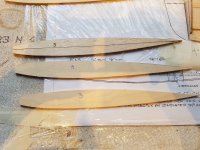
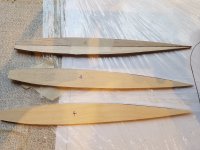
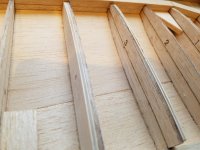
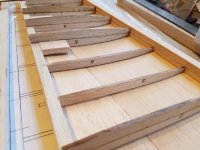
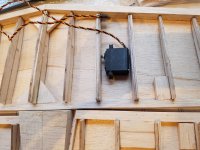
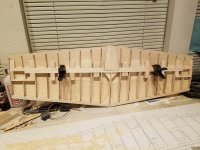
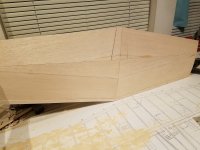
Thanks for the heads up on that. But I already have that well under control. I really don't have to run the servo wires that far. They will actually come up through the top of the stab so as to connect with the extension harness that will run down the center of the fuselage through the servo lead tubes.Don’t forget the holes in the ribs to run the servo wires. You could have drilled them before assembly. And a tube for the servo wire.
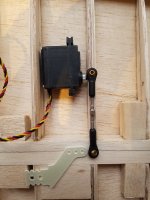
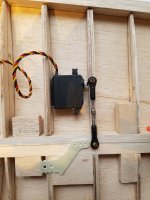
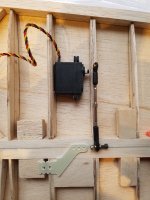
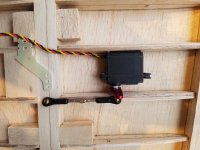
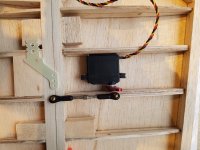
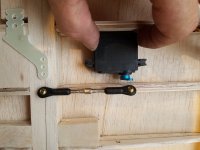
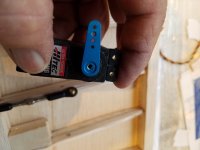
Decided to do some tinkering while laundry is going. I wanted to start planning the elevator servo installation. As planned, I will build a frame work spanning stab ribs 3 and 4. I will also cut lite ply servo bay doors that will attach to the frame work, they will have the servo mounting lugs attached to the inside of the door. This process should be fairly straight forward. With two exceptions. First, I owe Snoops an apology. I had planned a different servo lead route but have since realized it is not at all feasible. His observation of drilling the corresponding ribs to accept a servo lead tube, allowing easy installation of the servos was actually right on the money. Wish I had been thinking a little more in advance. In my defense I can only claim it was very late and my brain was broke. Lol. So I'll have to see what I can do to rectify my oversightedness. Second exception is I am really not 100% certain of which installation method would be the strongest configuration. They say that the shortest distance between two points is a straight line. While this is true, there can also be a mitigating factor of the distance of that straight line. I would appreciate you fellows thoughts and input on what you feel would be the best set up. Please note the photos that I have attached. It is my thought that the shorter turnbuckle would be the stronger of the two configurations. Also that the Servo arm output shaft closest to the hinge line would be the best way to go. Obviously I want to make the elevator connections has strong and absolutely flutter free as possible. There is no doubt in my mind that with the big 150cc up front pulling this plane through the air, there is going to be tremendous air pressure across those elevators. Any flutter at all could be seriously detrimental to the longevity of this massive Mustang. I am going to attempt using the 1" aluminum Hitec servo arms that are included with all Hitecs top line servos. If they are too short, I will go with the new 1.5" MPI arms I have been saving for this build.
What do you think fellas? I greatly appreciate all of your input and suggestions.
View attachment 108974 View attachment 108975 View attachment 108976 View attachment 108977 View attachment 108978 View attachment 108979 View attachment 108980
I would go with the shortest length of rod and the servo oriented with its output shaft closest to the control surface hinge line.
With the aircraft flying fast, large control surface movements are not required, so short arms and short linkages make the most sense.
As I see it and please just trying to help.
1. The Fiberglas horn you are showing if you are only using one it is likely to fail or twist away in stead of moving the elevator you need to have to of them so that the arm cannot twist Fiberglas bord is strong in one direction but not in twist motion.
2. Rest looks good like it.
3. Last comment mounting a servo flat on its side into the stabilizer is difficult. When I have done it I have aluminum angle made a cut out on one leg and screwed the servo to the angle and screwed the angle to flat wood block glued to the sheeting and the ribs. I never been able to have little wood post stand up strong enough to hold the servo and glue down onto a flat piece of wood.
4. With the servo on its side you do not have contend with operating angels it is all in line so the shorter the better.
Thanks gents for chiming in. I am pretty sure that I am going to set it up with the shortest link possible. Also with the servo output shaft closest to the hinge line. This eliminates the biggest majority of any possible weak links. Of course a control system is only as good as the hardware being used, I think this should be a very robust system. I will in fact be using two control horns just like what we use on all of our aerobatic planes. I have seen them set up with just one and honestly it would worry me. I only used the one laying on its side as a reference of the general location in relation to the hinge line and the distance to the output shaft of the servo. I am still fairly certain that I will be using the same method to mount the servos on the servo doors like my other smaller Mustangs. I've also had aerobatic planes with the servos installed the same way. I haven't had any problems so I think that's the way I wish I couldI would also say go with the shortest method possible but in this case it does look like that big of a difference and would probably be fine either way.
